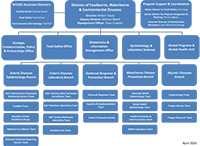Who We Are
Ever-Changing Challenges

Changes in society, technology, our environment, and microorganisms themselves are affecting the occurrence and complexity of foodborne, waterborne, and mycotic (fungal) diseases.
For example in the 1980s, E. coli 0157 first emerged and spread to contaminate a growing variety of foods. Prevention approaches—including heighted surveillance and monitoring, aggressive recall policies, and reduction in contamination throughout the food chain—were targeted at this type of E. coli and some other pathogens and showed some success. In fact, the rate of lab-confirmed cases of this E. coli O157 declined enough to meet the Healthy People 2010 target of <1 case for every 100,000 people living in the community.
On the other hand, multiresistant Salmonella are a growing challenge to human and animal health. Waterborne diseases, such as cholera and typhoid, although virtually nonexistent in the United States, cause needless disability and death globally. Fungal infections are common among immunocompromised patients and are difficult to diagnose and treat. Infections of animals can spread to humans by direct contact and by less obvious routes. Microbial adaptation is resulting in new—or previously unrecognized—pathogens.
Branches
The Division of Foodborne,Waterborne, and Environmental Diseases is made up of five branches, Enteric Diseases Epidemiology Branch, Enteric Diseases Laboratory Branch, Mycotic (Fungal) Diseases Branch, Outbreak Response and Prevention Branch and Waterborne Disease Prevention Branch. Their mission is to protect public health nationally and internationally through the prevention and control of disease, disability, and death caused by foodborne, waterborne, and environmentally transmitted infections.
How We Work
We strive to better understand these emerging, reemerging, drug-resistant, bacterial, parasitic, and mycotic pathogens and to discover the pathways they use to make people sick. We do this in collaboration with state health departments, academic researchers, federal regulatory agencies, and partners around the world, and use this information to improve prevention and inform policy. Our expertise builds on the following activities:
- Surveillance, investigations, and studies to define disease etiology and develop effective methods for diagnosis, prevention, and control
- Clinical, field, and laboratory research to develop, evaluate, and improve laboratory methodologies, materials, and therapeutic practices used for environmental detection, diagnosis, treatment, investigation, and control
- Environmental microbiology research activities that promote research on preventing infectious disease transmission from the environment to humans
- National and international epidemic aid and epidemiologic consultation upon request
- Scientific and technical assistance to other CDC components and assistance in professional training and proficiency testing requiring unique expertise or specialized equipment not otherwise available
- Designated national and international reference/diagnostic centers and services
- Clear health promotion strategies, campaigns, and messages to promote prevention
- Page last reviewed: May 3, 2016
- Page last updated: January 23, 2017
- Content source:


 ShareCompartir
ShareCompartir
